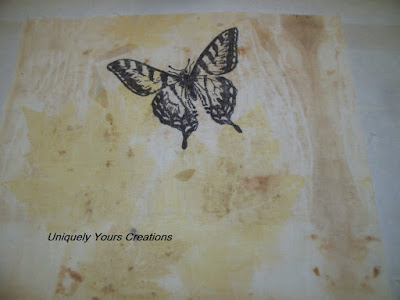in my head after reading some image
transfer techniques. I'm lazy; I wanted
something easy and not have to go out
to get an image printed somewhere else.
And using what I had in my house.
I searched google to see if anyone had
this idea before but I found nothing.
So I started experimenting.
This is a photo that I did back in March 2010. It's a black and white photograph of my Aunt from the 1940s. This was one of my first experiments that I did with Shout Stain
remover. Yes, it works!
And another from the same years - of the dragon - both using my hand dyed fabrics.
They are still in great shape as the day
I transferred them.
I made a tutorial in case you would
like to try this technique for your
projects.
Ready?
I suggest making a few samples pieces first just to get the hang of it and experiment.
Supplies needed
Background fabric (I suggest a light color)
Burnishing tool (old credit card)
Freezer paper
Regular printing paper
Paper or plastic cup
Paint Brush (or I even tried Q-tips)
Shout (stain remover)
A black and white image - if you don't have your own image; you can get one from http://thegraphicsfairy.com/

A printer that uses dyed-based inks. If you have a printer with pigmented inks; this method will not work.
For example: I use my old HP PSC 1400 series - my Epson has pigmented inks
1 - Print the image on white printing paper
Cut around the images leaving a space all around.
I suggest using a small sized image to practice.
I printed my images 3" x 5" on regular printing paper
2 - Cut 2 pieces of freezer paper at least 2" larger than your image. (the bottom piece
can be larger)
Lay down the freezer paper shiny side down. This is done to ensure that the dye doesn't stain your table or whatever surface you are working on.
3 - Lay down your fabric - right side up - on top of the freezer paper. (I'm using fabric that I dyed naturally with Oak leaves
and oak bark)
4 - Now lay down your image - right side down on top of the fabric. (make sure it's centered where you want it.
5 - Spray the Shout into a plastic cup - make sure that you have enough to cover the image.
6 - Dip the paintbrush into the shout but not too much as to make it puddle. (this will tear the paper and smudge if it's too much)
Now with slightly hard dabs, cover the image with the paintbrush making sure that the whole image is covered. You might have to dip the brush back into the Shout again.
7 - Put the other piece of freezer paper on top of the image (shiny side down) I do this because it lessens the chance of the image paper tearing.
8 - This is the part that takes patience and practice. Use an old credit card (or AAA) as a burnishing tool and pressing
down hard but gently - go back and forth over the image making sure that you burnish
the entire image. Tip - hold down the
paper with one hand so that nothing
slides around. I start at the right side
and work my way across.
9 - Then lift the paper off of the fabric
Please don't get upset or lose heart
if the first one doesn't work.
Like mine here---
You can see on the left side of the bottom wing - I missed a part!
Like I said before; it takes patience and practice but it does work.
Let the fabric dry and then with a warm
to hot iron (no steam) go over the printed fabric on the wrong side. This is heat
setting the dye.
And it's ready for your project!
Imagine and create something beautiful!














Very interesting. I might have to try this. How do I know if my printer uses dye or pigment based inks?
ReplyDeleteHi Karen - you can probably go to printers web site and they
Deletemight state what type of inks are used there. I did find
on Google a list of printers that use pigment based inks here
http://www.redrivercatalog.com/infocenter/tips/list-of-pigment-ink-inkjet-printers.html
Yes, very interesting...thank you for the website! Will be checking to see if my printer will work.
ReplyDeleteThank you for looking Penny! I hope your printer does work;
ReplyDeleteit's such a fun project!
This is very interesting. I like how clearly you wrote your tutorial and will turn back here when I give it a try. Thank you!
ReplyDelete